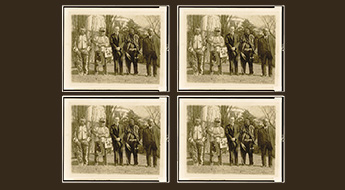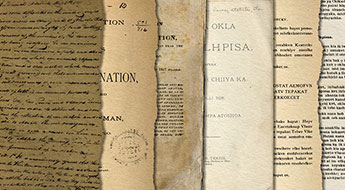- Home
- Who We Are
- Faculty Experts
- Beth Redbird
Beth Redbird

PhD, Sociology, Stanford University, 2016
Boundaries can be as formal as borders between nations, or as informal as cultural differences. Whether they are geographical, political, legal, or social, boundaries create inequality.
They limit the free flow of resources; restrict knowledge and ideas; and draw distinctions between ‘us’ and ‘them.’ I study the impact of boundaries on interaction, conflict and inequality.
My current work focuses on two areas:
The ways in which modern settler-colonial boundaries constrain and influence native nations.
And the flow of human movement within and between spaces.
Current Research
The Unending Frontier. The concept of invisible walls, restricting movement for people of color, is not new. “Ghettoes,” “barrios,” “Chinatowns,” and Reservations are all such spaces. “The ghetto is hope, it is despair, it is churches and bars. It is aspiration for change and it is apathy. It is vibrancy, it is stagnation. It is courage, and it is defeatism. It is cooperation and concern, and it is suspicion, competitiveness, and rejection. It is the surge towards assimilation, and it is alienation and withdrawal within the protective walls of the ghetto” (Clark 1989: 11). These enclaves of segregation are often accompanied by deteriorated housing, decreased health and high mortality, crime, drug addiction and alcoholism, and chronic unemployment; what Fanon called a geography “hungry for light” (Fanon 1968: 53). Yet, exploitation and oppression are not all that is found in these spaces. They are also places of community, home, and comfort. But reservations are also colonized spaces. “Indian land” and settler land are distinct, and often opposed, forms of property. Borderlands, the settled lands that touch Indian Country, are not just boundaries at the edges of an empire. They are sites of economic and resource exchange, information sharing, cultural intermixing, and power contestation. Sociologists often think of such spaces of exchange and interaction as increasing understanding and cultural growth. But reservations are places of the unfinished settler project, and so borderlands become places of territorialized political contestation. This is the argument put forth here: With territory comes sovereignty and legal jurisdiction, and because the maintenance of territorial distinctions is critical to the ongoing structure of settler-colonialism, so are ongoing jurisdictional disputes that continually enforce a segregated order.
Human Movement. Human interaction matters for well-being. Interacting frequently, particularly with a diverse collection of others, makes us more tolerant, increases information flow, improves mental and physical health, and increases labor market participation. The benefits of diverse interaction develop in two ways. First, social isolation is detrimental. Those with less social interaction experience more stress, have lower health outcomes, and are more likely to be hurt or die during periods of significant social disruption. Second, homophily, the tendency to associate with people who are similar to us, is also problematic as it reduces our access to resources, makes us less empathetic, and reduces generosity. This project utilizes anonymous GPS data to develop measures of the frequency, depth, and diversity of modern interactions. We have four primary goals: (1) describe the patterns of human interaction prior to the pandemic; (2) understand the inequality consequences of these patterns; (3) map and explore changes in human interaction during the pandemic; and (4) monitor pandemic recovery to understand the “new normal.”
Tribal Constitutions Project. Tribes develop structures of governance for many reasons. Some of these structures developed within a system of federal constraints, their nature being externally inflicted on the tribe. Others were designed to stave off federal involvement. Still others to reflect distinctly Indigenous priorities or history. We examine the development of sovereignty in three areas:
Tribal sovereignty and constitutional path dependency. How should we evaluate the development of tribal sovereignty in light of the colonial origins of tribal constitutionalization? The literature on the IRA constitutions is full of contradictions about the intentions of the federal government in early constitutions. How much did that early involvement determine tribal sovereignty, and to what extent do these early constitutions dictate the trajectory of tribal governance?
Constitutions, culture, and citizenship. American Indian identity is unique, in that it does not derive mainly from self-identification, but from an interaction of federal law, tribal constitutional sovereignty, citizenship, and institutional definitions. To be Indian in modern America is to be both American and not American (Porter 1999). While most Americans view “Native” as just another racial group, racial identity for Indians has always been a confluence of legal, economic, social, and political factors. The dividing line between mixed-race Indian and non-Indian is one of the most significant definitions in tribal life (Prucha 1973, Tallbear 2013), so much that Cook-Lynn (2001) compared being mixed-blood to being “voiceless.” Given its paramount import, tribal membership – its definition and evolution – has naturally produced one of the richest literatures in Native American studies (e.g. Champagne et al. 2005; Doerfler 2012, 2015). Indeed, the federal government itself played an extensive role in constructing, limiting, producing, and perverting tribal membership (Goldberg 2002).
Constitutions are thought to reflect and sometimes create a “people.” Tribes as nations derive their right to determine citizenship from more than 2,000 treaties and quasi-treaties signed with the federal government. This right has been tempered by historic forms of cultural genocide designed to explicitly reduce tribal enrollment so more land might be made available for White settlement. While most scholars discuss the ‘blood quantum’ as a colonial construct, this project traces the definition of tribal citizenship through constitutions to understand how citizenship develops in tangent with other tribal institutions and forms of sovereignty.
Legislative power and the development of tribal sovereignty. What are the various ways legislative power is constructed in tribal constitutions? How have different constitutional choices impacted the expansion (or diminution) of tribal sovereignty? Tribal constitutions are diverse in their approaches to structuring legislative authority. Legislative responsibility can lie with all tribal members, or with delegated representatives, and can be structured through tribal councils or delegated to subject-matter specific committees. The demarcation between legislative and administrative power can be blurred. Drawing on our unique database, we assess whether institutional design matters for the nature and expanse of a legislative areas and how tribes structure their governments to practically administer their sovereignty.
Selected Publications
Chang, S., E. Pierson, P. Wei Koh, J. Gerardin, B. Redbird, D. Grusky, and J. Leskovec. 2021. Mobility network models of COVID-19 explain inequities and inform reopening. Nature 589: 82–7.
Redbird, B. and A. Escamilla-Garcia. 2020. Borders within borders: The impact of occupational licensing on immigrant incorporation. Sociology of Race and Ethnicity 6(1): 22-45.
Redbird, B. 2017. The new closed shop: Economic and structural effects of occupational licensure. American Sociological Review 82(3): 600–24.
Redbird, B. and D. Grusky. 2016. The effects of the Great Recession: Income inequality and labor market. Annual Review of Sociology 42(1): 185–215.
Redbird, B. and D. Grusky. 2015. Rent, rent-seeking, and social inequality. In Emerging Trends in the Social and Behavioral Sciences: An Interdisciplinary, Searchable, and Linkable Resource, eds. R. Scott and S. Kosslyn (Hoboken, N.J.: John Wiley and Sons).
Chavez, K. and B. Redbird. 2015. Occupational licensure and changing barriers to immigrant workforce incorporation. In How Global Migration Changes the Workforce Diversity Equation, 294–319, eds. M. Pilati, H. Sheikh, F. Sperotti, and C. Tilly (Newcastle-upon-Tyne, U.K.: Cambridge Scholar Publications).

